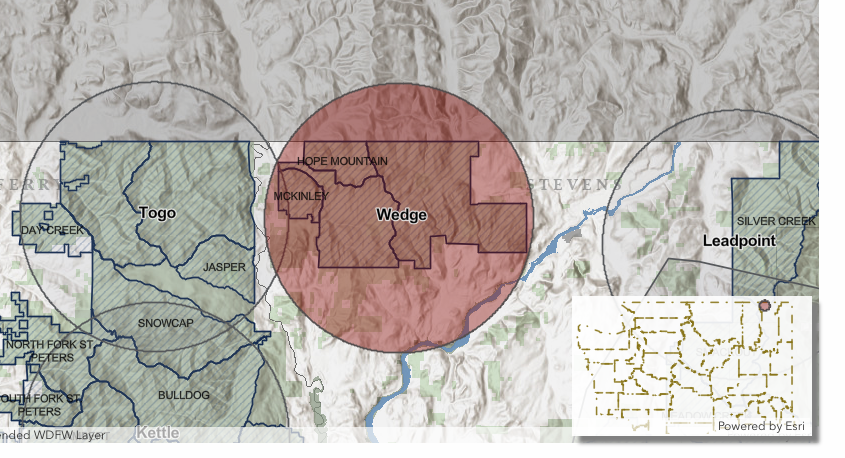
Lethal Removal Of 1 Wedge Pack Wolf Greenlighted By WDFW Director; Out-of-state Groups Go To Governor
Fast-moving morning on the Washington wolf front with a chronically depredating pack about to come under the gun and out-of-state wolf advocates appealing to Governor Inslee to reverse last month’s rejection by the Fish and Wildlife Commission of a petition that would have shackled when wolves can be killed.
Let’s take them one by one:
WDFW Director Kelly Susewind this morning authorized removing a member of the Wedge Pack which has killed at least two calves and injured 10 others in Northeast Washington since early May.

“The proactive and responsive non-lethal deterrents used by the affected livestock producers in the area this grazing season have not curtailed further depredations,” the agency stated this morning.
Spokeswoman Staci Lehman says there are three adults in the pack, which roams far northern Stevens County, and that they could have pups but none have been confirmed.
State wildlife managers say they expect wolf attacks to continue and that there aren’t any more “reasonable, additional reactive non-lethal tools that could be deployed.”
They say there have been nine separate depredation incidents since May, including five in the past 30 days.
Three within 30 days or four within a rolling 10-month window trigger the director’s consideration of removals.
This patch of the state has long seen wolf-livestock-related conflicts of all sorts, beginning with the old Wedge Pack being eradicated in 2012 and setting off a long-running battle between wolf advocates and the Diamond M Ranch, among others.
Diamond M saw eight of its calves injured by wolves while grazing a Colville National Forest allotment in July’s first half.
This year, Susewind has authorized removing two members of the Togo Pack to the west of the Wedge and the Leadpoint Pack to the east injured four calves in late June.
WDFW reports this morning that it hasn’t killed any Togo wolves but has “made multiple attempts,” and that there haven’t been any depredations in the pack’s range either since D-Day. The agency is now in an evaluation period.
Today’s Wedge announcement before 8 a.m. this morning gives wolf advocates one business day to challenge in court before operations begin.
Lehman says that while Friday is a mandatory furlough day at WDFW, the agency’s “wolf team is exempt .. . due to their workload and because they need to be able to respond for depredation investigations and other activities in a timely manner.”
Efforts could technically begin tomorrow, she says, but that depends on how fast things could get organized.
The removal authorization appears to have been the trigger for outside wolf groups to formally announce they were going to Governor Jay Inslee to request he reverse the Fish and Wildlife Commission’s unanimous late June rejection of their petition to require nonlethal tactics be used to reduce wolf-livestock conflicts.
Much of their stated ire centers around the Diamond M, which they say WDFW has removed 26 wolves on behalf of the operation.
The Center for Biological Diversity of Arizona, Cascadia Wildlands of Eugene, Western Watersheds Project of Idaho’s Sun Valley region and WildEarth Guardians of New Mexico claim that the “stakeholder process is broken” and say they want to “draft enforceable rules that limit when the state can kill endangered wolves for conflicts with livestock.”
Wolves in the eastern third of Washington were delisted from the federal Endangered Species Act in 2011, and while still listed under the state ESA, removals are guided by protocols developed in 2017 with WDFW’s Wolf Advisory Group stakeholders – instate representatives of the livestock, hunting and conservation worlds.
Going to Inslee may prove successful for CBD et al, as it was with cougar hunting changes approved by the commission several years ago and then reversed by the governer, but it’s also part of their multifront attempts to pick away at how wolves are managed in Washington, including lawsuits in state superior and US District courts.
But patience appears to also be wearing thin among instate wolf advocates
“We support the state, the Wolf-Livestock Interaction Protocol, and ranchers doing their best to prevent or reduce wolf-livestock conflicts across Eastern Washington. But after five consecutive years of cattle loss and wolf killing, the status quo simply can’t continue in the northern Kettle Range without serious social and political fallout,” said Conservation Northwest’s Chase Gunnell in a statement.
CNW is part of the WAG and has taken the not-easy-for-them path of largely supporting WDFW’s removals in the past. In a blog post, they contrast “heavy range riding” that may have kept the Togo Pack out of trouble with the “more work to be done” in both the Kettles and Wedge in terms of sustained human presence and in the wolf-livestock protocols’ “expectations of range riding to ensure accountability for state-funded riders.”
They want cattle checked “almost daily with no more than a two-day gap” between rounds. Funding has been made available for the expense that entails, but not all operators are welcoming riders.
